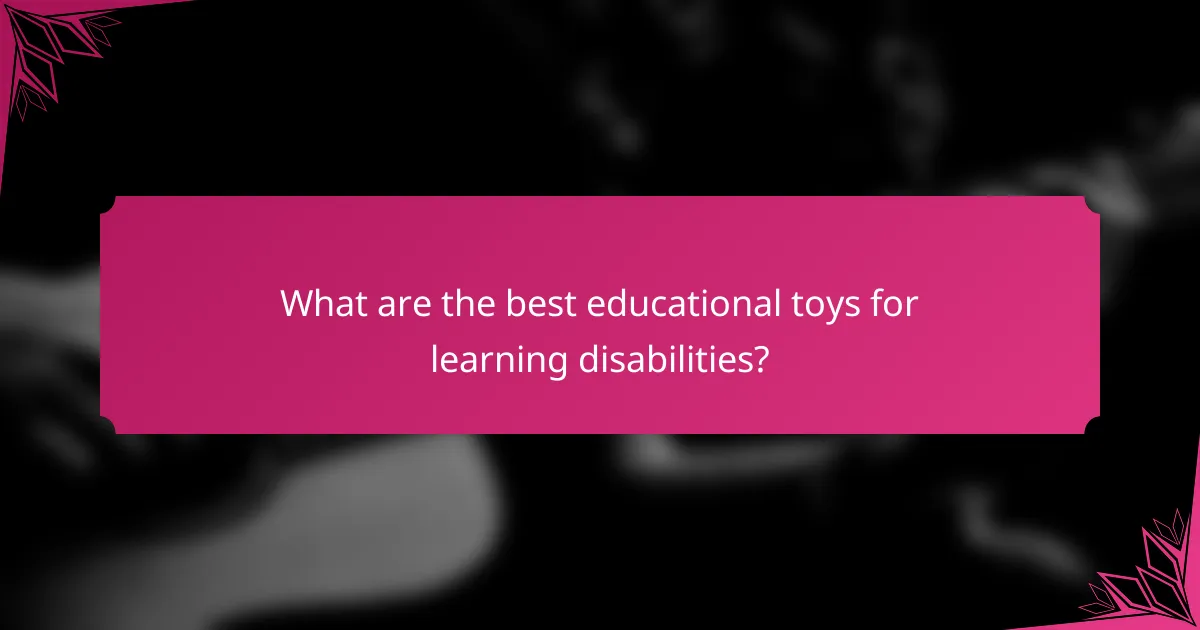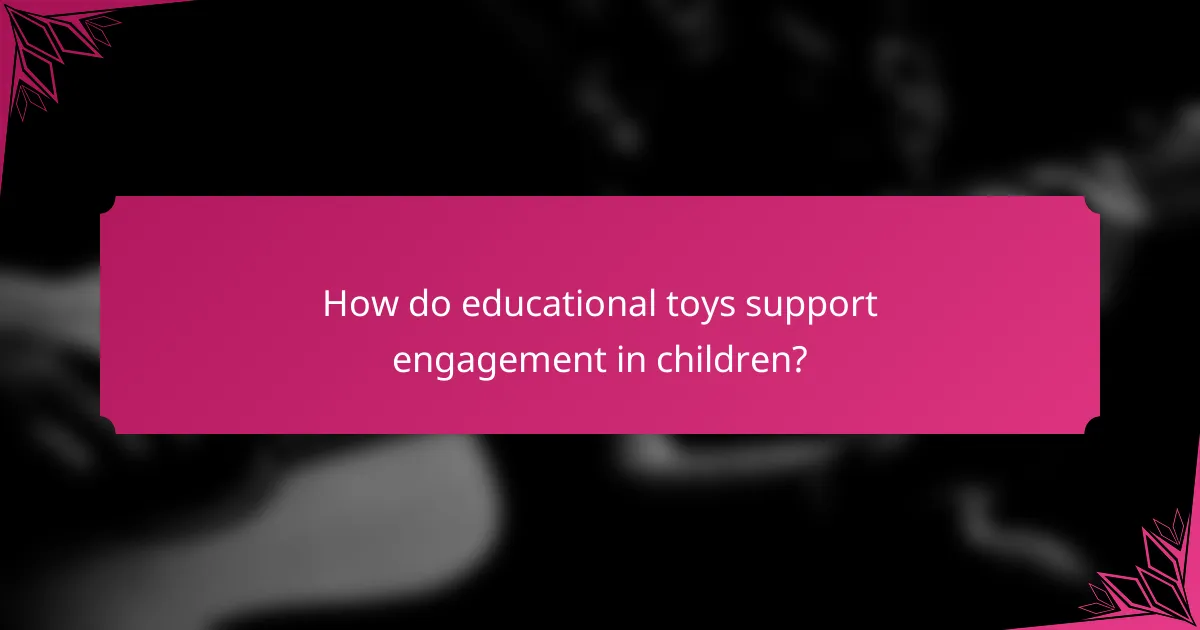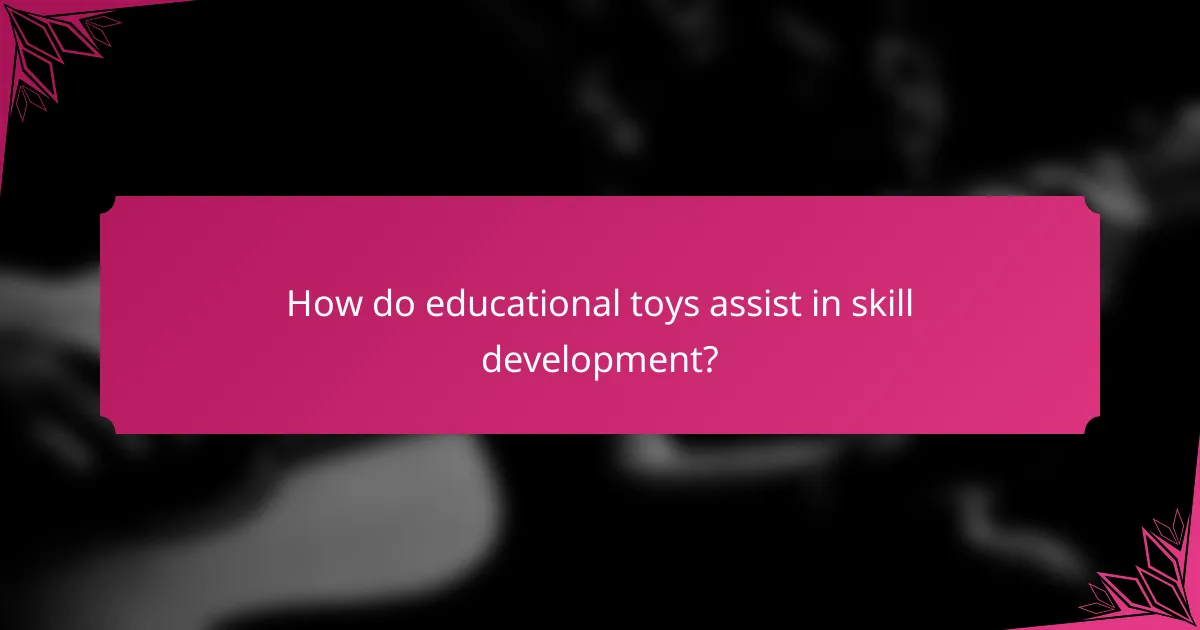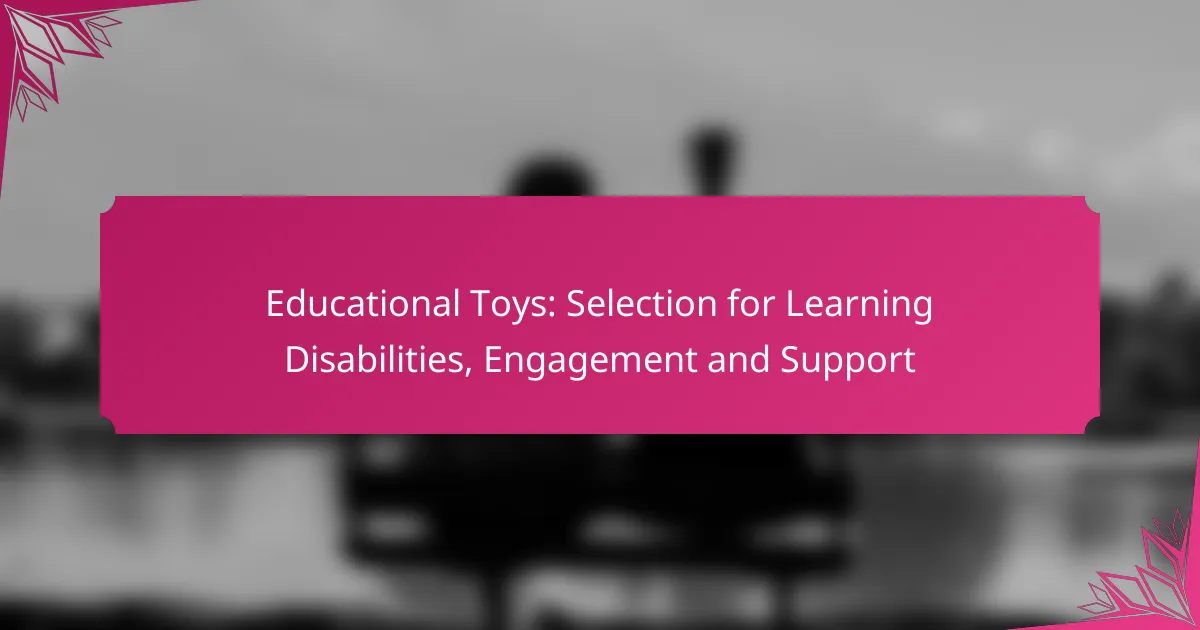Choosing the right educational toys for children with learning disabilities can greatly enhance their engagement and skill development. These toys are designed to cater to various learning styles, promoting cognitive and motor skills through interactive play. When selecting toys, it’s crucial to consider age appropriateness, developmental benefits, and safety standards to ensure a positive learning experience.

What are the best educational toys for learning disabilities?
The best educational toys for learning disabilities are those that promote engagement, skill development, and sensory exploration. These toys cater to various learning styles and can significantly enhance cognitive and motor skills in children with different needs.
LEGO Education sets
LEGO Education sets are designed to foster creativity and problem-solving skills through hands-on building activities. They encourage children to construct models, which can enhance spatial awareness and fine motor skills.
When selecting a set, consider the child’s interests and developmental level. Options range from simple block sets for younger children to more complex robotics kits for older kids. Look for sets that include instructions and challenges to guide learning.
Melissa & Doug puzzles
Melissa & Doug puzzles are excellent for developing cognitive skills such as shape recognition and problem-solving. These puzzles often feature bright colors and engaging themes, making them appealing to children.
Choose puzzles that match the child’s skill level, starting with simpler designs and gradually increasing complexity. Wooden puzzles are particularly durable and can withstand frequent use, making them a practical choice for active learners.
VTech learning tablets
VTech learning tablets offer interactive learning experiences through games and activities tailored to various age groups. These devices can cover subjects like math, reading, and science, providing a comprehensive educational tool.
Look for tablets with parental controls and adjustable difficulty levels to ensure the content remains engaging. Many models also include touch screens and styluses, which can help improve hand-eye coordination.
Fisher-Price activity centers
Fisher-Price activity centers are designed to stimulate sensory exploration and motor skills in young children. These centers often feature a variety of textures, sounds, and activities that keep children engaged.
When choosing an activity center, consider the child’s age and developmental stage. Look for features that promote standing, crawling, or walking, as these can support physical development while keeping the child entertained.
Play-Doh creative sets
Play-Doh creative sets encourage imaginative play and fine motor skill development through sculpting and molding activities. Children can express their creativity while enhancing dexterity and hand strength.
Select sets that include various tools and molds to keep the experience fresh and exciting. Supervise playtime to ensure safety, especially for younger children who may be prone to putting small pieces in their mouths.

How do educational toys support engagement in children?
Educational toys enhance engagement in children by fostering active participation and stimulating their senses. These toys are designed to capture attention, encourage interaction, and promote learning through play, making them particularly beneficial for children with learning disabilities.
Interactive features promote participation
Interactive features in educational toys, such as buttons, touchscreens, and movement sensors, encourage children to engage actively with the toy. These elements can motivate children to explore and experiment, which is essential for learning. For instance, toys that respond to touch or voice can create a more immersive experience, prompting children to participate rather than passively observe.
When selecting toys, look for those that offer multiple ways to interact. Toys that allow children to manipulate parts or change settings can cater to various learning styles, enhancing their involvement and enjoyment.
Hands-on activities enhance focus
Hands-on activities provided by educational toys help children maintain focus by engaging them physically and mentally. Toys that require building, assembling, or sorting can channel children’s energy into productive tasks, making it easier for them to concentrate. For example, construction sets or puzzles can keep children occupied while developing critical thinking skills.
Consider toys that allow for open-ended play, as they encourage creativity and sustained attention. Avoid overly complex toys that may frustrate children; instead, choose those that offer a balance of challenge and achievable goals.
Visual and auditory stimuli increase interest
Visual and auditory stimuli in educational toys play a crucial role in capturing children’s interest. Bright colors, engaging shapes, and sounds can stimulate curiosity and encourage exploration. Toys that incorporate music or sound effects can also enhance the learning experience by making it more enjoyable and memorable.
When selecting toys, prioritize those with varied sensory inputs. Look for options that combine visual and auditory elements, such as musical instruments or interactive storybooks, to keep children engaged and motivated to learn.

What criteria should be considered when selecting educational toys?
When selecting educational toys, it’s essential to consider factors such as age appropriateness, developmental benefits, and safety standards compliance. These criteria ensure that the toys are suitable for the child’s needs and contribute positively to their learning experience.
Age appropriateness
Age appropriateness is crucial when choosing educational toys, as children develop skills at different rates. Toys should match the child’s developmental stage to ensure engagement and effectiveness. For example, toys designed for toddlers often focus on basic motor skills, while those for older children may promote critical thinking and problem-solving.
Check age recommendations on packaging, which typically indicate suitable age ranges. This helps avoid frustration or disinterest that can arise from toys that are too complex or too simple.
Developmental benefits
Educational toys should provide specific developmental benefits, such as enhancing cognitive, social, and motor skills. Look for toys that encourage creativity, collaboration, and fine motor skills, as these are essential for overall growth. For instance, building blocks can improve spatial awareness and coordination.
Consider toys that align with the child’s interests, as this increases engagement and motivation. For example, if a child enjoys art, selecting toys that promote creativity, like coloring kits or craft sets, can be particularly beneficial.
Safety standards compliance
Safety standards compliance is vital when selecting educational toys, especially for younger children. Look for toys that meet recognized safety regulations, such as ASTM or EN71, which ensure that products are free from harmful materials and have no small parts that could pose choking hazards.
Always check for labels indicating non-toxic materials and age-appropriate warnings. Regularly inspect toys for wear and tear, as damaged toys can become unsafe. Prioritizing safety helps create a secure environment for children to learn and play.

How do educational toys assist in skill development?
Educational toys play a crucial role in skill development by providing interactive and engaging ways for children to learn. These toys are designed to enhance various abilities, including fine motor skills, cognitive skills, and social skills, making them valuable tools for children, especially those with learning disabilities.
Fine motor skills through manipulation
Fine motor skills are developed through the manipulation of toys that require precise hand movements. Toys like building blocks, puzzles, and threading beads encourage children to grasp, pinch, and move objects, which strengthens their hand-eye coordination and dexterity.
When selecting toys for fine motor skill development, consider options that vary in difficulty. For instance, start with larger blocks for younger children and progress to smaller, more intricate pieces as their skills improve. Look for toys that offer different textures and shapes to keep children engaged.
Cognitive skills via problem-solving
Cognitive skills are enhanced through toys that challenge children to think critically and solve problems. Games that involve sorting, matching, or sequencing can stimulate cognitive development by encouraging children to recognize patterns and make decisions.
Choose toys that promote open-ended play, such as construction sets or logic puzzles, which allow for multiple solutions and creative thinking. Incorporating a mix of guided and independent play can help children develop their problem-solving skills effectively.
Social skills through cooperative play
Cooperative play is essential for developing social skills, and educational toys can facilitate this interaction. Toys that require teamwork, such as board games or group-building activities, encourage children to communicate, share, and collaborate with peers.
When selecting toys for social skill development, prioritize those that involve multiple players and require turn-taking or joint problem-solving. This not only helps children learn to work together but also fosters empathy and understanding of others’ perspectives.

What are the benefits of using educational toys in therapy?
Educational toys provide numerous benefits in therapy, particularly for individuals with learning disabilities. They promote engagement, enhance cognitive skills, and create a supportive environment that fosters learning through interactive play.
Enhances learning through play
Educational toys facilitate learning by making it enjoyable and interactive. When children engage with toys designed for educational purposes, they often absorb information more effectively compared to traditional methods. For example, puzzles can improve problem-solving skills, while building blocks can enhance spatial awareness.
Consider toys that align with specific learning goals, such as language development or math skills. Look for options that encourage exploration and creativity, allowing children to learn at their own pace. Incorporating a variety of toys can cater to different learning styles, ensuring a well-rounded educational experience.
Reduces anxiety in therapeutic settings
Using educational toys in therapy can significantly reduce anxiety for children, creating a more relaxed atmosphere. Familiar and engaging toys can help ease tension, making it easier for children to focus on therapeutic activities. This comfort can lead to more productive sessions and better outcomes.
To maximize this benefit, choose toys that are visually appealing and tactile. Items like stress balls, fidget spinners, or sensory bins can provide calming effects. Additionally, integrating play into therapy sessions can help children express themselves more freely, further alleviating anxiety and promoting emotional well-being.
